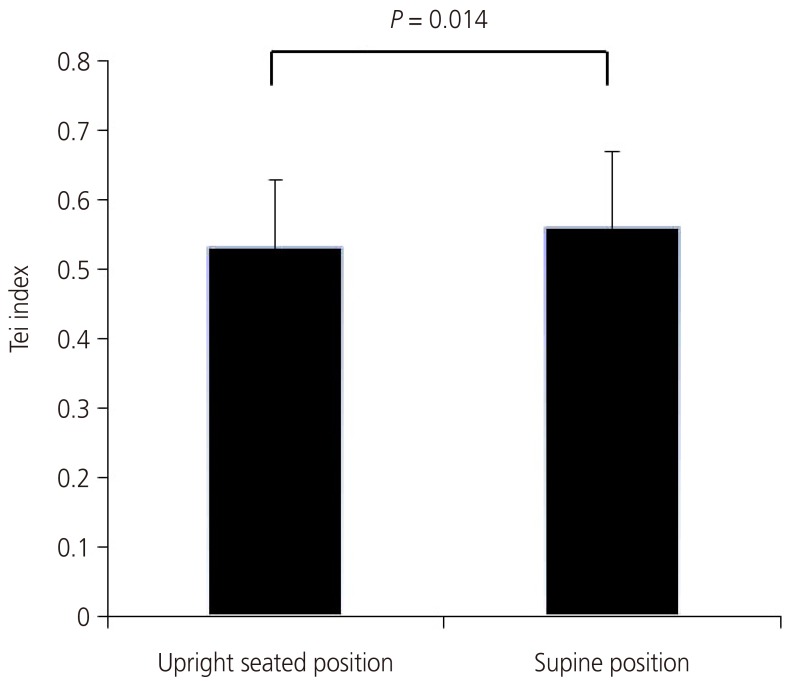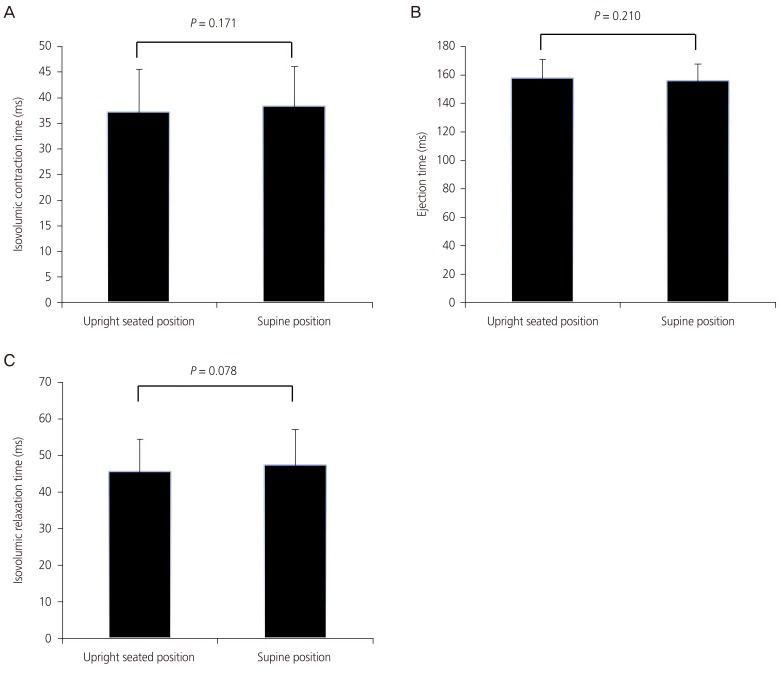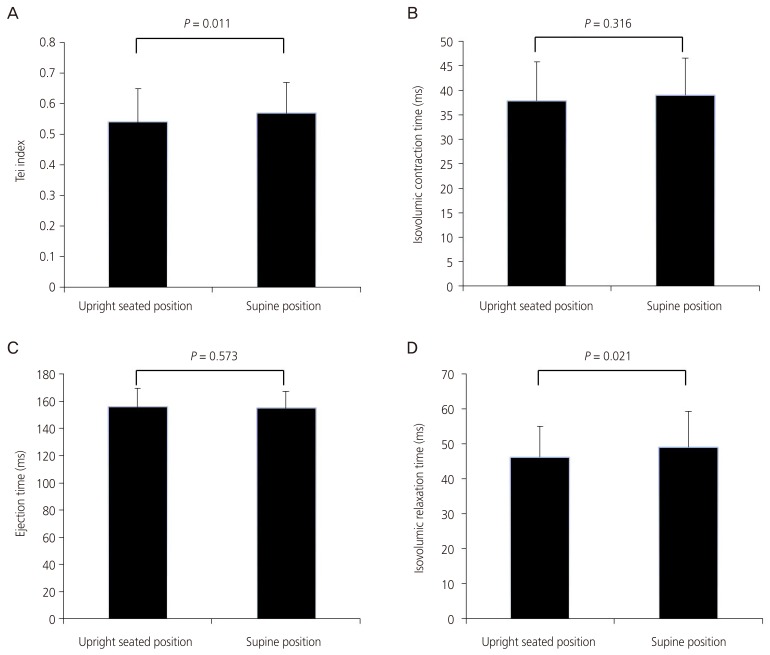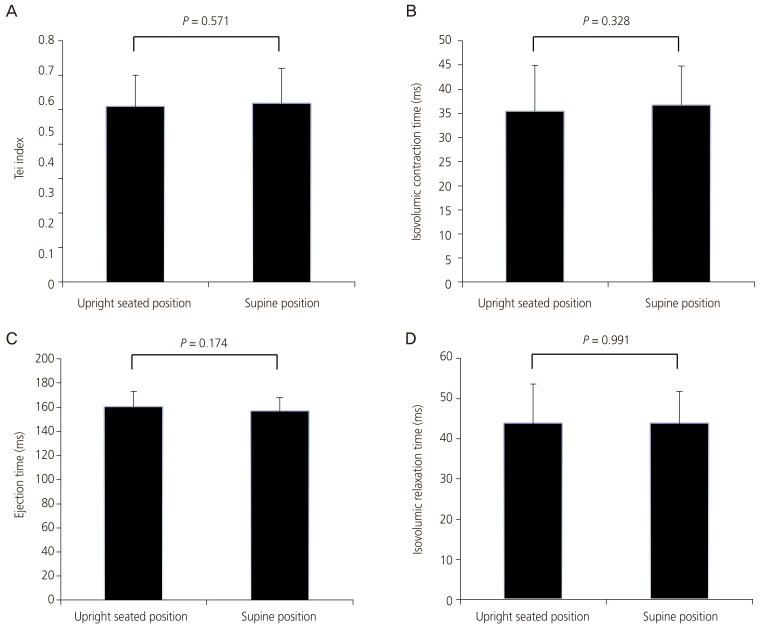Obstet Gynecol Sci.
2016 Nov;59(6):427-433. 10.5468/ogs.2016.59.6.427.
Adaptive responses of cardiac function to fetal postural change as gestational age increases
- Affiliations
-
- 1Department of Obstetrics and Gynecology, Korea University College of Medicine, Seoul, Korea. md_cho@hanmail.net
- KMID: 2378566
- DOI: http://doi.org/10.5468/ogs.2016.59.6.427
Abstract
OBJECTIVE
The cardiovascular system maintains homeostasis through a series of adaptive responses to physiological requirements. However, little is known about the adaptation of fetal cardiac function to gravity, according to gestational age. In the present study, we aimed to evaluate the adaptive responses of cardiac function to postural changes, using Tei index measurements.
METHODS
Fetal echocardiography and Doppler examination were performed on 114 women with vertex singleton pregnancies at 19 to 40 weeks' gestation. Participants were placed in an upright seated position, and the Tei index for fetal left ventricular cardiac function was measured. The women were then moved into a supine position and the Tei index was re-measured.
RESULTS
The mean Tei index when measured in an upright seated position was significantly lower than that measured in a supine positioning for all fetuses (0.528±0.103 vs. 0.555±0.106, P=0.014, respectively). This difference was also noted in fetuses with a gestational age of 28-40 weeks (0.539±0.107 vs. 0.574±0.102, P=0.011, respectively). However, there was no difference in the Tei index between an upright seated and a supine position among fetuses with a gestational age of <28 weeks (0.505±0.091 vs. 0.516±0.103, P=0.571, respectively).
CONCLUSION
Postural changes from an upright seated to a supine position result in an increased Tei index after a gestational age of 28 weeks. This appears to reflect maturation in the adaptive responses of the fetal cardiovascular system to postural changes.
Keyword
MeSH Terms
Figure
Reference
-
1. Boron WF, Boulpaep EL. Medical physiology. Philadelphia (PA): W.B. Saunders;2003.2. Jones AY, Dean E. Body position change and its effect on hemodynamic and metabolic status. Heart Lung. 2004; 33:281–290. PMID: 15454907.
Article3. Klabunde RE. Cardiovascular physiology concepts. Philadelphia (PA): Lippincott Williams & Wilkins/Wolters Kluwer;2012.4. Watanabe N, Reece J, Polus BI. Effects of body position on autonomic regulation of cardiovascular function in young, healthy adults. Chiropr Osteopat. 2007; 15:19. PMID: 18045493.
Article5. Fukushima A, Nakai K, Itoh M, Horigome H, Suwabe A, Tohyama K, et al. Assessment of fetal autonomic nervous system activity by fetal magnetocardiography. Clin Med Cardiol. 2008; 2:33–39.
Article6. Pennati G, Fumero R. Scaling approach to study the changes through the gestation of human fetal cardiac and circulatory behaviors. Ann Biomed Eng. 2000; 28:442–452. PMID: 10870901.
Article7. Wallwitz U, Schneider U, Nowack S, Feuker J, Bauer S, Rudolph A, et al. Development of integrative autonomic nervous system function: an investigation based on time correlation in fetal heart rate patterns. J Perinat Med. 2012; 40:659–667. PMID: 23093257.
Article8. Ichizuka K, Matsuoka R, Hasegawa J, Shirato N, Jimbo M, Otsuki K, et al. The Tei index for evaluation of fetal myocardial performance in sick fetuses. Early Hum Dev. 2005; 81:273–279. PMID: 15814209.
Article9. Lakoumentas JA, Panou FK, Kotseroglou VK, Aggeli KI, Harbis PK. The Tei index of myocardial performance: applications in cardiology. Hellenic J Cardiol. 2005; 46:52–58. PMID: 15807396.10. Friedman D, Buyon J, Kim M, Glickstein JS. Fetal cardiac function assessed by Doppler myocardial performance index (Tei Index). Ultrasound Obstet Gynecol. 2003; 21:33–36. PMID: 12528158.
Article11. Tei C, Ling LH, Hodge DO, Bailey KR, Oh JK, Rodeheffer RJ, et al. New index of combined systolic and diastolic myocardial performance: a simple and reproducible measure of cardiac function. A study in normals and dilated cardiomyopathy. J Cardiol. 1995; 26:357–366. PMID: 8558414.12. Plotnick GD, Kmetzo JJ, Gottdiener JS. Effect of autonomic blockade, postural changes and isometric exercise on Doppler indexes of diastolic left ventricular function. Am J Cardiol. 1991; 67:1284–1290. PMID: 2035455.
Article13. Kmetzo JJ, Plotnick GD, Gottdiener JS. Effect of postural changes and isometric exercise on Doppler-derived measurements of diastolic function in normal subjects. Chest. 1991; 100:357–363. PMID: 1864105.
Article14. Dernellis J, Tsiamis E, Stefanadis C, Pitsavos C, Toutouzas P. Effects of postural changes on left atrial function in patients with hypertrophic cardiomyopathy. Am Heart J. 1998; 136:982–987. PMID: 9842010.
Article15. Guazzi M, Maltagliati A, Tamborini G, Celeste F, Pepi M, Muratori M, et al. How the left and right sides of the heart, as well as pulmonary venous drainage, adapt to an increasing degree of head-up tilting in hypertrophic cardiomyopathy: differences from the normal heart. J Am Coll Cardiol. 2000; 36:185–193. PMID: 10898433.
Article16. Gottdiener J. Measuring diastolic function. J Am Coll Cardiol. 1991; 18:83–84. PMID: 2050946.
Article17. Zhao XB, Shan JZ. Changing fetal position through maternal posture. Zhonghua Fu Chan Ke Za Zhi. 1993; 28:517–519. 567PMID: 8313740.18. Hoyer D, Nowack S, Bauer S, Tetschke F, Rudolph A, Wallwitz U, et al. Fetal development of complex autonomic control evaluated from multiscale heart rate patterns. Am J Physiol Regul Integr Comp Physiol. 2013; 304:R383–R392. PMID: 23269479.
Article19. Hallak M, Kirshon B, Smith EO, Cotton DB. Amniotic fluid index. Gestational age-specific values for normal human pregnancy. J Reprod Med. 1993; 38:853–856. PMID: 8277480.
- Full Text Links
- Actions
-
Cited
- CITED
-
- Close
- Share
- Similar articles
-
- Estimating Fetal Cardiac Output by Doppler Echocardiography
- Cardiovascular Doppler Flow Waveforms in Human Fetuses
- Recent advances in management of fetal growth restriction
- Estimation of Fetal Growth by Measurement of Birth Weight for Gestational Age in Newborn
- Developmental Changes of Spectral and Chaotic Indexes of Heart Rate Variability in Normal Fetuses





